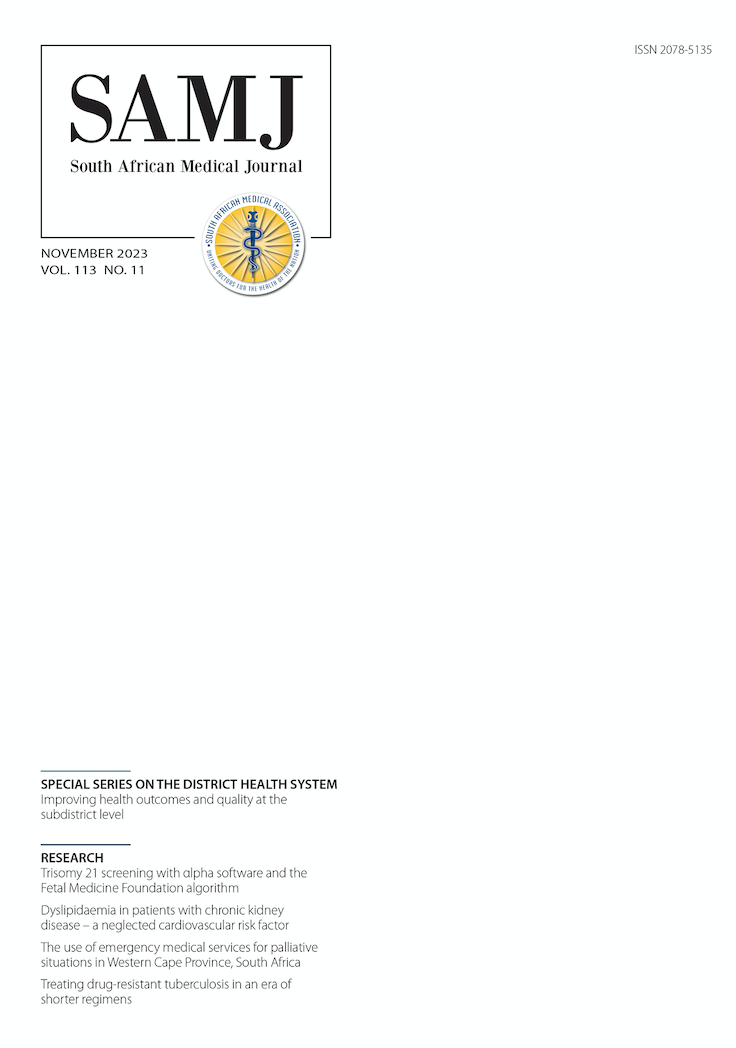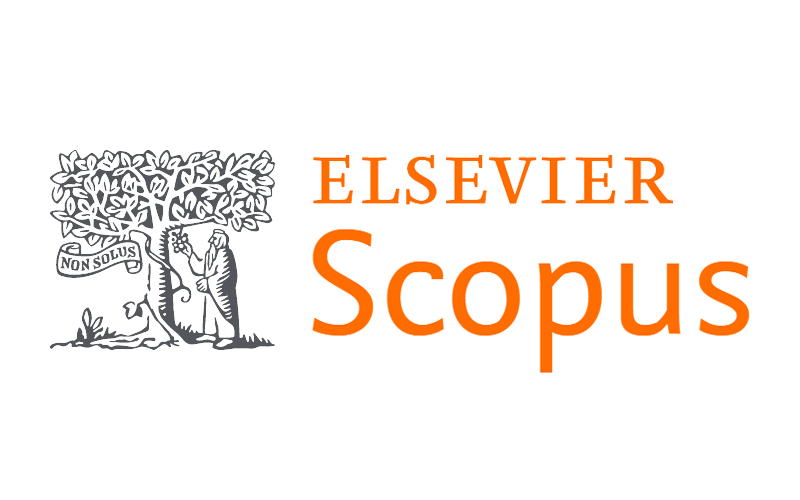Biliary atresia: The profile, management and outcome of patients treated at a tertiary hospital in central South Africa
DOI:
https://doi.org/10.7196/SAMJ.2023.v113i11.845Keywords:
biliary atresia, developing country, Lesotho, South AfricaAbstract
Background. Biliary atresia (BA) is an obstructive inflammatory disease of the bile ducts. Without intervention, the disease rapidly progresses to liver cirrhosis and fibrosis, with end-stage liver failure and death occurring within the first 3 years of life. It is the most common indication for liver transplantation (LT) in the paediatric population. The management of BA in South Africa (SA) faces multiple challenges, such as late referrals and socioeconomic burdens, with suboptimal outcomes.
Objectives. To determine risk factors and shortcomings that are detrimental to the outcome of the paediatric patient population by reviewing the profile, management and outcome of patients with BA treated at Universitas Academic Hospital Complex (UAHC), Bloemfontein, SA.
Methods. This was a retrospective analytical record review of all patients diagnosed with BA and treated at UAHC from 1 January 2009 to 31 December 2019.
Results. In total, 67 patients were included; 74.6% were female, and 86.6% were black Africans. Most (62.7%) had isolated BA. A Kasai portoenterostomy (KPE) was performed in 32 patients (47.8%). Of 5 patients referred for LT evaluation, 2 received a transplant. Of 55 patients with known outcomes, 5.5% (n=3) survived and 94.5% (n=52) died after receiving a KPE or palliative treatment. Of the 3 patients who were alive at the end of the study period, 1 had a KPE and 2 had LTs.
Conclusion. Late presentation, cholangitis and cessation of bile flow after an initial successful KPE, and socioeconomic challenges are issues of concern and had a detrimental influence on the outcome of BA in our study population. Implementing screening measures and education programmes at the primary healthcare level is essential to diagnose and refer BA patients timeously. Establishing support systems to assist socioeconomically disadvantaged patients will enable them to qualify for LT.
References
Davenport M. Biliary atresia. Semin Pediatr Surg 2005;14(1):42-48. https://doi.org/10.1053/j. sempedsurg.2004.10.024
Superina R. Biliary atresia and liver transplantation: Results and thoughts for primary liver transplantation in select patients. Pediatr Surg Int 2017;33(12):1297-1304. https://doi.org/10.1007/ s00383-017-4174-4
Lin YC, Chang MH, Liao SF, et al. Decreasing rate of biliary atresia in Taiwan: A survey, 2004 - 2009. Pediatrics 2011;128(3):e530-e536. https://doi.org/10.1542/peds.2011-0742
Wada H, Muraji T, Yokoi A, et al. Insignificant seasonal and geographical variation in incidence of biliary atresia in Japan: A regional survey of over 20 years. J Pediatr Surg 2007;42(12):2090-2092. https://doi.org/10.1016/j.jpedsurg.2007.08.035
Livesey E, Cortina Borja M, Sharif K, et al. Epidemiology of biliary atresia in England and Wales (1999 - 2006). Arch Dis Child Fetal Neonatal Ed 2009;94(6):F451-F455. https://doi.org/10.1136/ adc.2009.159780
Chardot C, Carton M, Spire-Bendelac N, le Pommelet C, Golmard JL, Auvert B. Epidemiology of biliary atresia in France: A national study 1986 - 96. J Hepatol 1999;31(6):1006-1013. https://doi. org/10.1016/s0168-8278(99)80312-2
Jimenez-Rivera C, Jolin-Dahel KS, Fortinsky KJ, Gozdyra P, Benchimol EI. International incidence and outcomes of biliary atresia. J Pediatr Gastroenterol Nutr 2013;56(4):344-354. https://doi.org/10.1097/ MPG.0b013e318282a913
Hopkins PC, Yazigi N, Nylund CM. Incidence of biliary atresia and timing of hepatoportoenterostomy in the United States. J Pediatr 2017;187:253-257. https://doi.org/10.1016/j.jpeds.2017.05.006
Chiu CY, Chen PH, Chan CF, Chang MH, Wu TC; Taiwan Infant Stool Color Card Study Group. Biliary atresia in preterm infants in Taiwan: A nationwide survey. J Pediatr 2013;163(1):100-3.e1. https://doi.org/10.1016/j.jpeds.2012.12.085
Van Wessel DB, Boere T, Hulzebos CV, et al. Preterm infants with biliary atresia: A nationwide cohort analysis from the Netherlands. J Pediatr Gastroenterol Nutr 2017;65(4):370-374. https://doi. org/10.1097/MPG.0000000000001692
Tam PKH, Yiu RS, Lendahl U, Andersson ER. Cholangiopathies – towards a molecular understanding [published correction appears in EBioMedicine 2018 Oct;36:564]. EBioMedicine 2018;35:381-393. https://doi.org/10.1016/j.ebiom.2018.08.024
Burns J, Davenport M. Adjuvant treatments for biliary atresia. Transl Pediatr 2020;9(3):253-265.
https://doi.org/10.21037/tp.2016.10.08
Davenport M. Biliary atresia: From Australia to the zebrafish. J Pediatr Surg 2016;51(2):200-205.
https://doi.org/10.1016/j.jpedsurg.2015.10.058
Sokol RJ, Mack C, Narkewicz MR, Karrer FM. Pathogenesis and outcome of biliary atresia: Current concepts. J Pediatr Gastroenterol Nutr 2003;37(1):4-21. https://doi.org/10.1097/00005176- 200307000-00003
Harpavat S, Finegold MJ, Karpen SJ. Patients with biliary atresia have elevated direct/conjugated bilirubin levels shortly after birth. Pediatrics 2011;128(6):e1428-e1433. https://doi.org/10.1542/ peds.2011-1869
Davenport M, Savage M, Mowat AP, Howard ER. Biliary atresia splenic malformation syndrome: An etiologic and prognostic subgroup. Surgery 1993;113(6):662-668.
Asai A, Miethke A, Bezerra JA. Pathogenesis of biliary atresia: Defining biology to understand clinical phenotypes. Nat Rev Gastroenterol Hepatol 2015;12(6):342-352. https://doi.org/10.1038/ nrgastro.2015.74
Schwarz KB, Haber BH, Rosenthal P, et al. Extrahepatic anomalies in infants with biliary atresia: Results of a large prospective North American multicenter study. Hepatology 2013;58(5):1724-1731. https://doi.org/10.1002/hep.26512
Zani A, Quaglia A, Hadzić N, Zuckerman M, Davenport M. Cytomegalovirus-associated biliary atresia: An aetiological and prognostic subgroup. J Pediatr Surg 2015;50(10):1739-1745. https://doi. org/10.1016/j.jpedsurg.2015.03.001
Parolini F, Hadzic N, Davenport M. Adjuvant therapy of cytomegalovirus IgM + ve associated biliary atresia: Prima facie evidence of effect. J Pediatr Surg 2019;54(9):1941-1945. https://doi.org/10.1016/j. jpedsurg.2018.12.014
Lakshminarayanan B, Davenport M. Biliary atresia: A comprehensive review. J Autoimmun 2016;73:1- 9. https://doi.org/10.1016/j.jaut.2016.06.005
Kaur N, Goyal G, Garg R, Tapasvi C, Chawla S, Kaur R. Potential role of noninvasive biomarkers during liver fibrosis. World J Hepatol 2021;13(12):1919-1935. https://doi.org/10.4254/wjh.v13.i12.1919
Bravo AA, Sheth SG, Chopra S. Liver biopsy. N Engl J Med 2001;344(7):495-500. https://doi. org/10.1056/NEJM20010215344070
Capparelli MA, Ayarzabal VH, Halac ET, et al. Preoperative risk factors for the early failure of the Kasai portoenterostomy in patients with biliary atresia. Pediatr Surg Int 2021;37(9):1183-1189. https://doi. org/10.1007/s00383-021-04933-y
El-Araby HA, Saber MA, Radwan NM, Taie DM, Adawy NM, Sira AM. Temporal histopathological changes in biliary atresia: A perspective for rapid fibrosis progression. Ann Hepatol 2021;21:100263. https://doi.org/10.1016/j.aohep.2020.09.007
Chardot C, Buet C, Serinet MO, et al. Improving outcomes of biliary atresia: French national series 1986 - 2009. J Hepatol 2013;58(6):1209-1217. https://doi.org/10.1016/j.jhep.2013.01.040
Bondoc AJ, Taylor JA, Alonso MH, et al. The beneficial impact of revision of Kasai portoenterostomy for biliary atresia: An institutional study. Ann Surg 2012;255(3):570-576. https://doi.org/10.1097/ SLA.0b013e318243a46e
KakosCD,ZiogasIA,AlexopoulosSP,TsoulfasG.Managementofbiliaryatresia:Totransplantornot to transplant. World J Transplant 2021;11(9):400-409. https://doi.org/10.5500/wjt.v11.i9.400
Scottoni F, Davenport M. Biliary atresia: Potential for a new decade. Semin Pediatr Surg 2020;29(4):150940. https://doi.org/10.1016/j.sempedsurg.2020.150940
Serinet MO, Wildhaber BE, Broué P, et al. Impact of age at Kasai operation on its results in late childhood and adolescence: A rational basis for biliary atresia screening. Pediatrics 2009;123(5):1280- 1286. https://doi.org/10.1542/peds.2008-1949
Chung PHY, Zheng S, Tam PKH. Biliary atresia: East versus West. Semin Pediatr Surg 2020;29(4):150950. https://doi.org/10.1016/j.sempedsurg.2020.150950Taylor SA, Venkat V, Arnon R, et al. Improved outcomes for liver transplantation in patients with biliary atresia since pediatric end- stage liver disease implementation: Analysis of the Society of Pediatric Liver Transplantation Registry. J Pediatr 2020;219:89-97. https://doi.org/10.1016/j.jpeds.2019.12.023
Nio M, Ohi R, Miyano T, et al. Five- and 10-year survival rates after surgery for biliary atresia: A report from the Japanese Biliary Atresia Registry. J Pediatr Surg 2003;38(7):997-1000. https://doi.org/10.1016/ s0022-3468(03)00178-7
DavenportM,OngE,SharifK,etal.BiliaryatresiainEnglandandWales:Resultsofcentralisationand new benchmark. J Pediatr Surg 2011;46(9):1689-1694. https://doi.org/10.1016/j.jpedsurg.2011.04.013 34. Davenport M, Grieve A. Maximizing Kasai portoenterostomy in the treatment of biliary atresia:
Medical and surgical options. S Afr Med J 2012;102(11 Pt 2):865-867. https://doi.org/10.7196/
SAMJ.6120
Levin LN. Biliary atresia at Red Cross War Memorial Children’s Hospital: A retrospective descriptive study reviewing the age of presentation, clinical course and outcome of infants presenting to RCWMCH with biliary atresia. Master’s thesis. Cape Town: Department of Paediatrics and Child Health, Faculty of Health Sciences, University of Cape Town, 2016. http://hdl.handle.net/11427/22822 (accessed 30 October 2019).
Moore SW, Zabiegaj-Zwick C, Nel E. Problems related to CMV infection and biliary atresia. S Afr Med J 2012;102(11 Pt 2):890-892. https://doi.org/10.7196/SAMJ.6163
Spearman CW, McCulloch M, Millar AJ, et al. Liver transplantation at Red Cross War Memorial Children’s Hospital. S Afr Med J 2006;96(9 Pt 2):960-963.
Lala SG, Britz R, Botha J, Loveland J. Paediatric liver transplantation for children treated at public health facilities in South Africa: Time for change. S Afr Med J 2014;104(11):829-832. https://doi. org/10.7196/SAMJ.8624
Van der Schyff F, Terblanche AJ, Botha JF. Improving poor outcomes of children with biliary atresia in South Africa by early referral to centralised units. JPGN Rep 2021;2(2):e073 https://doi.org/10.1097/ PG9.0000000000000073
Zuckerman M, Hajinicolaou C. Incidence and outcome of biliary atresia in black infants in Soweto (South Africa): Review of cases from 1993 - 1996. J Pediatr Gastroenterol Nutr 1998;26(5):587.
The French METAVIR Cooperative Study Group, Bedossa P. Intraobserver and interobserver variations in liver biopsy interpretation in patients with chronic hepatitis C. Hepatology 1994;20(1):15- 20. https://doi.org/10.1002/hep.1840200104
Davenport M, Caponcelli E, Livesey E, Hadzic N, Howard E. Surgical outcome in biliary atresia: Etiology affects the influence of age at surgery. Ann Surg 2008;247(4):694-698. https://doi.org/10.1097/ SLA.0b013e3181638627
Lien TH, Chang MH, Wu JF, et al. Effects of the infant stool color card screening program on 5-year outcome of biliary atresia in Taiwan. Hepatology 2011;53(1):202-208. https://doi.org/10.1002/ hep.24023
Alonso EM, Ye W, Hawthorne K, et al. Impact of steroid therapy on early growth in infants with biliary atresia: The Multicenter Steroids in Biliary Atresia Randomised Trial. J Pediatr 2018;202:179-185.e4. https://doi.org/10.1016/j.jpeds.2018.07.002
Karangwa OR. A retrospective review of the outcome of children presenting to Tygerberg Children’s Hospital with biliary atresia. PhD thesis. Cape Town: Stellenbosch University, 2016. https:// www.semanticscholar.org/paper/A-retrospective-review-of-the-outcome-of-children-Karangwa/ bfff8b317d009a9a79a438126be21887ba3b4989 (accessed 4 October 2023).
Human Sciences Research Council. The Fifth South African National HIV Prevalence, Incidence, Behaviour and Communication Survey, 2017. Pretoria: HSRC, 2018. https://www.hsrc.ac.za/uploads/ pageContent/9234/SABSSMV_Impact_Assessment_Summary_ZA_ADS_cleared_PDFA4.pdf (accessed 29 May 2019).
Xu Y, Yu J, Zhang R, et al. The perinatal infection of cytomegalovirus is an important etiology for biliary atresia in China. Clin Pediatr (Phila) 2012;51(2):109-113. https://doi.org/10.1177/0009922811406264 48. Davenport M, Puricelli V, Farrant P, et al. The outcome of the older (≥100 days) infant with biliary
atresia. J Pediatr Surg 2004;39(4):575-581. https://doi.org/10.1016/j.jpedsurg.2003.12.014
Sanghai SR, Shah I, Bhatnagar S, Murthy A. Incidence and prognostic factors associated with biliary
atresia in western India. Ann Hepatol 2009;8(2):120-122.
Koga H, Wada M, Nakamura H, et al. Factors influencing jaundice-free survival with the native liver
in post-portoenterostomy biliary atresia patients: Results from a single institution. J Pediatr Surg 2013;48(12):2368-2372. https://doi.org/10.1016/j.jpedsurg.2013.08.007
Downloads
Published
Issue
Section
License
Copyright (c) 2023 E Brits, S M le Grange

This work is licensed under a Creative Commons Attribution-NonCommercial 4.0 International License.
Licensing Information
The SAMJ is published under an Attribution-Non Commercial International Creative Commons Attribution (CC-BY-NC 4.0) License. Under this license, authors agree to make articles available to users, without permission or fees, for any lawful, non-commercial purpose. Users may read, copy, or re-use published content as long as the author and original place of publication are properly cited.
Exceptions to this license model is allowed for UKRI and research funded by organisations requiring that research be published open-access without embargo, under a CC-BY licence. As per the journals archiving policy, authors are permitted to self-archive the author-accepted manuscript (AAM) in a repository.
Publishing Rights
Authors grant the Publisher the exclusive right to publish, display, reproduce and/or distribute the Work in print and electronic format and in any medium known or hereafter developed, including for commercial use. The Author also agrees that the Publisher may retain in print or electronic format more than one copy of the Work for the purpose of preservation, security and back-up.





